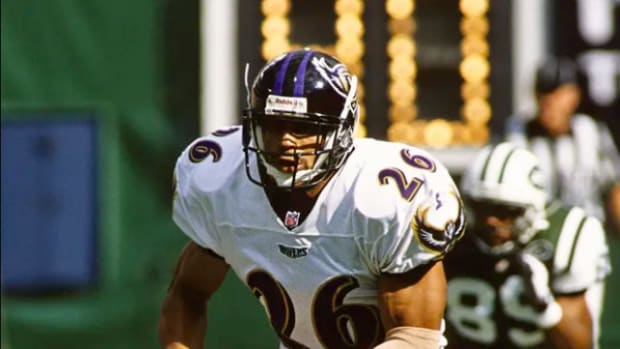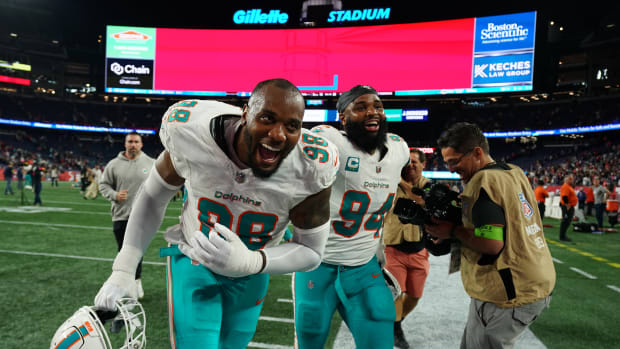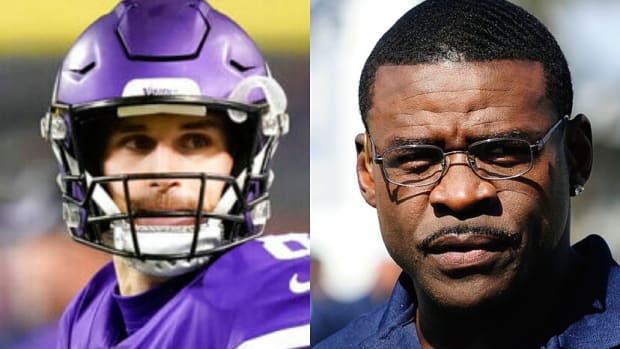Michael Thomas Is the Key to Saints-Rams
Yes, the Saints last week rushed for 137 yards, while their No. 2-ranked run defense held Philly’s ground game to just 49 yards. And the Rams amassed an unfathomable 273 yards rushing against Dallas, surrendering only an almost equally unfathomable 50 to league rushing champ Ezekiel Elliott.
But let’s be honest: Even with outstanding ground games, the Saints and Rams are playing for the NFC championship because of their aerial assaults. Both are afforded unique dimension from running backs—backfield screen master Todd Gurley for L.A. and super flex piece Alvin Kamara for New Orleans—but the backbone of these passing attacks is formed by stud wide receivers.
The Rams have maybe the league’s best all-around duo in the highly refined Robert Woods and turbo-driven Brandin Cooks, though L.A.’s aerial success derives predominantly from its detailed, deceptive play-action, which makes this passing game about the scheme as much as the personnel. New Orleans’s aerial scheme is also great, though it would look a lot less “great” without Michael Thomas. Which is why the third-year wideout is the key difference-maker entering Sunday’s contest.
Recall that when the Rams and Saints met back in Week 9, Thomas had 12 catches for 211 yards, including a 72-yard touchdown that, like many of his other catches, came after burning Marcus Peters. The Rams cornerback was only traveling with Thomas because Aqib Talib was out with his 10-week ankle injury. It’s been a different Rams pass D since Talib’s return in Week 13, and on Sunday Thomas can expect to see a lot of the well-traveled 12th-year star corner. The Rams don’t typically travel their corners with specific receivers when Peters and Talib are both in, but Talib’s lanky frame is too nice a fit against Thomas’s physicality.
BENOIT:Mahomes vs. Belichick, Round 2—What the Patriots should do differently in the AFC title game
Still, the Saints will not have to tweak their approach if Talib follows Thomas. Talib is an off-coverage corner who has a keen sense for simultaneously reading the QB and multiple routes. Thomas is a borderline genius route runner, deft at disguising his patterns and setting up breaks. And Drew Brees, who is better with deceptive body language and eye manipulation than any other passer of this era, is a difficult QB to read. Putting Talib on Thomas would be more of a survival tactic for the Rams. Thomas, when you factor in his ability on contested catches, is a player who—to dig up the old cliché than Dan Patrick buried with sarcasm years ago on SportsCenter—you cannot stop, you can only hope to contain.
This is especially true when you consider how the Saints use Thomas. At times he’ll align in the slot (where Talib is less comfortable—as is Peters, for that matter). Often, Thomas is one of just two wideouts on the field, as the Saints are more base personnel-driven (two tight ends or two backs) than people realize. Some offensive coaches over the years have privately said that Rams defensive coordinator Wade Phillips becomes predictable when you play base personnel (though you don’t hear this as much now as you did before to Phillips won a Super Bowl with the 2015 Broncos). Predictability against Brees is poisonous, and it would surely mean single zone coverage against Thomas, which the Saints feast on.
PIERCE:Patriots’ discovery of a ground game makes them dangerous
Part of New Orleans’s success against zone, particularly in obvious passing situations, comes from shrewdly leveraging Kamara and Thomas together. In empty formations, they often align together on the weak side, where it’s all but impossible to double both. In traditional formations, Kamara’s route will often work near or underneath Thomas’s route, attacking the same group of zone defenders. If it’s man-to-man, those routes will intersect, creating natural rubs on defenders. (The Rams were bested here a few times in that Week 9 meeting.)
L.A.’s saving grace is that Brees no longer has the arm strength to push the ball vertically unless his pocket is clean. New Orleans’s stalwart O-line matches up well to L.A.’s pass rush, except inside, where no one matches up well to Aaron Donald. Compromise the 6-foot Brees’s interior pocket and you condense New Orleans’s passing game to throws of 20 yards and shorter. That’s what happened during the stretch in December in which the Saints, in games against the Cowboys, Panthers and Bucs, uncharacteristically struggled to score. Thomas, one of the NFL’s best intermediate receivers, can still hurt a defense in a constricted passing game, but not having to defend over the top, a defense has a much better chance at competing. That’s what this game comes down to. If the Rams keep Thomas in check, they’ll win. If they don’t, they’ll lose.
TWEET ELABORATION
Three commonalities among these offenses:
1. They’re great at using formations to out-leverage the defense. The Patriots and Chiefs are brilliant flexing into different spread alignments. The Saints are, too, and they also condense their formations, putting more receivers near the middle of the field, where they can run rub routes and are a threat to go in any direction. And the Rams, of course, live in condensed formations almost full-time.
2. They incorporate jet-sweep action significantly in their designs, adding complexity to even the most basic of plays.
3. They use their running backs in the passing game. The Rams and Chiefs have expansive backfield screen games. So do the Patriots and Saints, who also have unique flex weapons in James White and Alvin Kamara.
DEE FORD
Jets stud safety Jamal Adams recently made a public pitch for his team to sign Ford in free agency this spring. But the Jets, and other teams, likely won’t have that chance. Coming off the best season of a promising career that has been pocked by injuries and, early on, up-and-down play, Ford fits the exact profile of a typical franchise-tagged player. The Chiefs will want to see if he can do in 2019 what he did in 2018 (including a career-high 13 sacks and a first Pro Bowl nod). In the more immediate future, if Kansas City’s defense on Sunday performs even close to how it (shockingly) did last week against Indy, you can bet that big plays from Ford will have factored.
ALL-PRO VOTING
My former boss, Peter King, drew some kudos for publishing his All-Pro ballot. So in a blatant display of mimicry, I’ll do the same. Below is my ballot. You can file complaints at AndyBenoitNFL@gmail.com, I’ll publish some of the most reasonable next week or soon after.
The hardest decisions were:
• Defensive Tackle—Akiem Hicks over Fletcher Cox.
• Cornerback—Byron Jones over Kyle Fuller … Fuller made more big plays, but Jones gave up fewer plays and drew bigger matchups, giving the Cowboys important man coverage dimension.
• Left guard—Rodger Saffold over Quenton Nelson … The Colts rookie was phenomenal in the second half of the season but had too many poor snaps in pass protection over the first half. Yes, those early season games were months ago, but they count just as much as the recent games and must be taken into full consideration.
OFFENSE
QB: Patrick Mahomes, Chiefs
RB: Ezekiel Elliott, Cowboys
WR: DeAndre Hopkins, Texans
WR: Tyreek Hill, Chiefs
TE: Zach Ertz, Eagles
FLEX: Christian McCaffrey, Panthers
LT: David Bakhtiari, Packers
LG: Rodger Saffold, Rams
C: Maurkice Pouncey, Steelers
RG: Zack Martin, Cowboys
RT: Mitchell Schwartz, Chiefs
ROHAN:The Incredible Feats of Young Andy Reid and the Story Behind That 1971 Punt, Pass & Kick Video
DEFENSE
EDGE: J.J. Watt, Texans
EDGE: Khalil Mack, Bears
INTERIOR: Aaron Donald, Rams
INTERIOR: Akiem Hicks, Bears
LB: Luke Kuechly, Panthers
LB: Darius Leonard, Colts
LB: Bobby Wagner, Seahawks
CB: Stephon Gilmore, Patriots
CB: Byron Jones, Cowboys
SLOT: Bryce Callahan, Bears
S: Kevin Byard, Titans
S: Harrison Smith, Vikings
SPECIAL TEAMS
K: Justin Tucker, Ravens
P: Michael Dickson, Seahawks
KR: Andre Roberts, Jets
PR: Tarik Cohen, Bears
ST: Corey Littleton, Rams
LET’S RESOLVE TO SAY 2019 CORRECTLY
My least favorite part of the NFL draft is when Roger Goodell is first announcing a pick. He says, “With the [whatever number] pick of the two-thousand eighteen NFL draft… . ” Goodell is not the only one; it’s astounding how many people say, “two thousand,” sticking to the old way of speaking that was appropriate in 2000 and maybe even the following nine years. But it became just an awful mouthful that next decade, when we could snappily describe the year as “twenty-ten.” This year is not “two-thousand-nineteen,” it’s “twenty-nineteen.” (See the difference in efficiency?)
This will fix itself next year, as broadcasters and the small-talk lovers who think they’re giving color to our daily interactions will be relentless with clever quips about it being the year “twenty-twenty.” (Brace yourself for “perfect vision” puns.) But wouldn’t it be nice if beforehand we could proactively all get on the same page about the proper way to state the year? Let’s resolve to say “twenty-nineteen.”
Question or comment? Email us at talkback@themmqb.com.




































